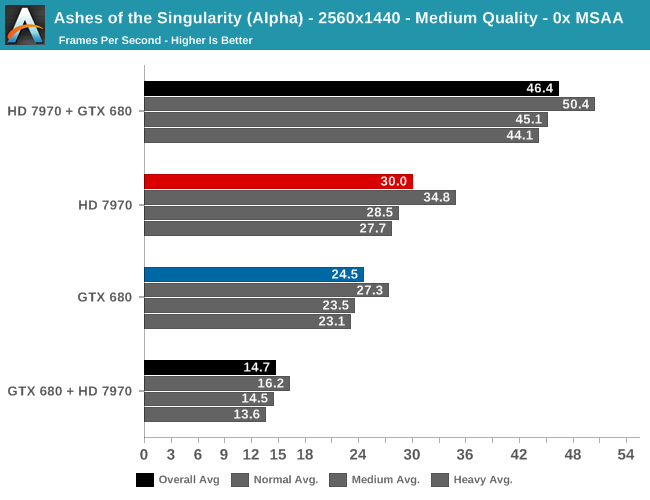GeForce + Radeon: Previewing DirectX 12 Multi-Adapter with Ashes of the Singularity
by Ryan Smith on October 26, 2015 10:00 AM ESTAshes GPU Performance: Single & Mixed 2012 GPUs
While Ashes’ mutli-GPU support sees solid performance gains with current-generation high-end GPUs, we wanted to see if those gains would extend to older DirectX 12 GPUs. To that end we’ve put the GeForce GTX 680 and the Radeon HD 7970 through a similar test, running the Ashes’ benchmark at 2560x1440 with Medium image quality and no MSAA.

First off, unlike our high-end GPUs there’s a distinct performance difference between our AMD and NVIDIA cards. The Radeon HD 7970 performs 22% better here, just averaging 30fps to the GTX 680’s 24.5fps. So right off the bat we’re entering an AFR setup with a moderately unbalanced set of cards.
Once we do turn on AFR, two very different things happen. The GTX 680 + HD 7970 setup is an outright performance regression, with performance 40% from the single GTX 680 Ti. On the other hand the HD 7970 + GTX 680 setup sees an unexpectedly good performance gain from AFR, picking up a further 55% to 46.4fps.
As this test is a smaller number of combinations it’s not clear where the bottlenecks are, but it’s none the less very interesting how we get such widely different results depending on which card is in the lead. In the GTX 680 + HD 7970 setup, either the GTX 680 is a bad leader or the HD 7970 is a bad follower, and this leads to this setup spinning its proverbial wheels. Otherwise letting the HD 7970 lead and GTX 680 follow sees a bigger performance gain than we would have expected for a moderately unbalanced setup with a pair of cards that were never known for their efficient PCIe data transfers. So long as you let the HD 7970 lead, at least in this case you could absolutely get away with a mixed GPU pairing of older GPUs.










180 Comments
View All Comments
ImSpartacus - Monday, October 26, 2015 - link
Yeah, I expected it to be pretty bad in the first year or two. Really fascinating results.shing3232 - Monday, October 26, 2015 - link
Yep I wonder how intel GPU would help for that matterDemon-Xanth - Monday, October 26, 2015 - link
It's likely a deal as this hypothetical situation:You have four pizza cooks: Al, Arnie, Nate, and Nick.
They all take 10 minutes to prep a pizza.
Al and Arnie take 3 minutes to spread the dough, and 7 to put on the toppings.
Nate and Nick take 7 minutes to spread the dough, but only 3 to put on the toppings.
Al and Arnie together can make crank a pizza out every 5 minutes, Nate and Nick can do the same. But Al and Nick (in that order) can put them out in 3, while Nate and Artie take 7.
So the order of stacking becomes important.
Torgog - Monday, October 26, 2015 - link
Now I'm hungry.Manch - Monday, October 26, 2015 - link
If Nate and Artie are making pizzas, what the hell happened to Arnie?! :DMr Perfect - Monday, October 26, 2015 - link
He ran to da choppa.Okay, that was bad...
AndrewJacksonZA - Tuesday, October 27, 2015 - link
Lol, nice one! :-)yzzir - Monday, October 26, 2015 - link
Based on your assumptions for Al and Nick and Nate and Arnie:Al takes 3 minutes to spread dough
Arnie take 7 minutes to put on toppings
Nate takes 7 minutes to spread dough
Nick take 3 minutes to put on toppings
It takes 7 minutes (after the initial 10 minutes for the first) for Al and Arnie to crank out a pizza, assuming Al continues spreading dough for the next pizza as soon as he finishes spreading dough for the previous pizza, so 3 minutes of work done by Al are hidden by arnies 7 minutes of work.
It also take 7 minutes (after the initial 10 minutes for the first) Nate and Nick to crank out a pizza,
assuming Nate continues spreading dough for the next pizza as soon as he finishes spreading dough for the previous pizza, 4 minutes of idle time are added to Nick's 3 minutes of work waiting on Nate to finish spreading pizza.
Gigaplex - Monday, October 26, 2015 - link
I think the 5 minute figures comes from each person taking 10 minutes to do a compete pizza, but since they're getting 2 pizzas per 10 minutes, that's an average of 1 per 5 minutes.Ryan Smith - Monday, October 26, 2015 - link
I love that analogy. However that only works if you use a more involved rendering mode than AFR, where the work within a single frame gets split up among multiple GPUs. With AFR it's more like all of the cooks have to complete pizzas on their own without any help from the other.